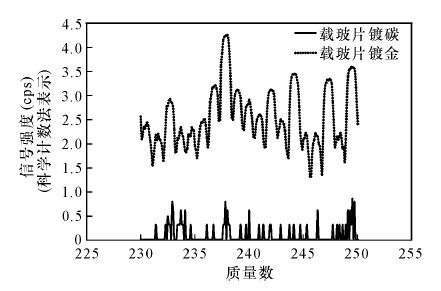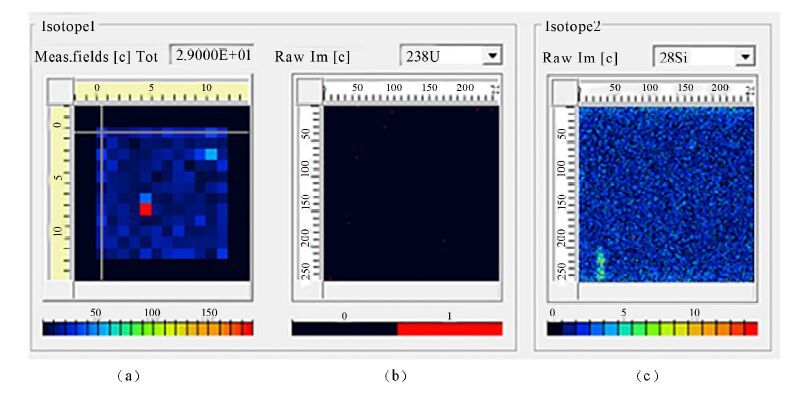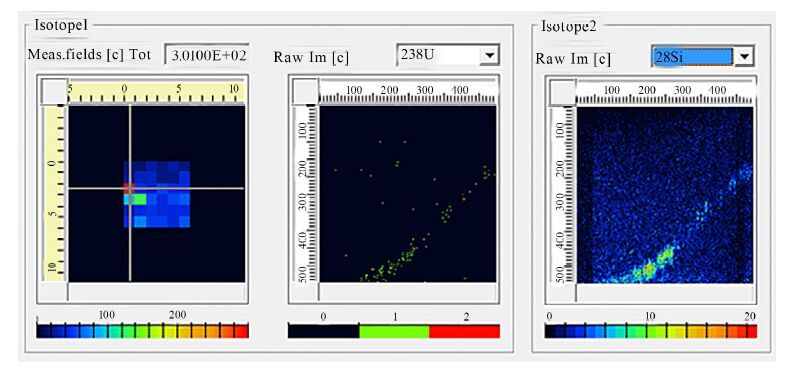Determination of the Distribution of Uranium in Glass Solidified Samples by Secondary Ionization Mass Spectrometry
-
摘要: 玻璃固化是一种常用的高放废液固化方法,其优点在于具有较高的抗化学介质侵蚀的能力和很好的辐照稳定性、热稳定性和机械稳定性,其不足之处在于抗水浸出等性能有所下降而使其安全性需要进一步通过抗浸出实验来进行衡量和确认。使用二次离子质谱(SIMS)分析玻璃固化体中的放射性成分(如铀元素)的分布及浸出行为等各项指标,是一种评估玻璃固化体抗浸出性能的分析手段。本文应用SIMS测试模拟玻璃固化体,以碳作为镀膜材料通过真空蒸发镀碳的方法优化样品制备条件,有效地解决了样品导电性差的问题,235U/238U同位素测定结果约为7.9‰±0.395‰,基本符合制作模拟样品时所使用的天然铀的同位素特征(235U/238U参考值约7.3‰)。研究表明,建立的方法实现了铀元素同位素丰度的测量,能直接显示铀的分布情况,该方法可为研究玻璃固化体中放射性元素的浸出行为提供一定的技术支持。Abstract: Glass solidification is a common method for curing highly radioactive waste liquid. This method has the advantages of high resistance to chemical corrosion, and good radiation, thermal, and mechanical stability. However, the disadvantage is the decline of resistance to water leaching so that the reliability of the result needs to be confirmed by an anti-leaching test. Using Secondary Ionization Mass Spectrometry (SIMS) to analyze the composition distribution and leaching behavior of radioactive components (such as uranium) in the solid glass is a method for evaluating the ability of resistance to leaching of solidified glass. The simulated glass solidified sample was tested by SIMS and the results are reported and discussed in this paper. Carbon was used as the coating material during vacuum evaporation coating on the surface of the sample in order to overcome the poor conductivity of the sample. The isotopic composition of natural uranium is about 7.3‰. And the ratio of 235U/238U in the prepared solid glass is 7.9‰±0.395‰. The research indicates that the method can determine the measurement of the isotopic abundance of uranium and directly show its distribution. This method can provide technical support for the study of the leaching behavior of radioactive elements in solidified glass samples.
-
Keywords:
- glass solidified samples /
- leaching behavior /
- SIMS /
- uranium /
- isotopic abundance
-
珍珠岩是火山喷发的酸性熔岩经急剧冷却而成的玻璃质岩石,是一种非金属矿产,因其具有珍珠裂隙结构而得名[1, 2]。我国珍珠岩矿床主要产于我国大陆地壳活动频繁的中生代火山活动区域,北起黑龙江,南达南海海滨,长3000公里火山岩带里蕴藏着丰富的珍珠岩矿资源[3]。珍珠岩在1000~1300℃高温条件下其体积可以迅速膨胀4~30倍,故又统称为膨胀珍珠岩[4]。由于珍珠岩中结晶水、二氧化硅、氧化钾、氧化钠等常量成分含量的差异,对其独特的膨胀性能、绝热性能等物理性能有着重要的影响[5],因此快速、准确地分析珍珠岩矿中的化学成分,可对珍珠岩矿的地质勘查、开发利用以及全面评价珍珠岩的质量提供科学依据。
目前,对于珍珠岩矿石中Si、Al、Fe、Ca、Mg、Ti、K、Na等主量元素含量的测定,大多采用容量法[6]、重量法[7]、分光光度法[7]、原子吸收光谱法等传统分析方法,这些方法分析手续繁琐,周期较长、耗材,而且劳动强度较大。方林霞等[8]用盐酸-氢氟酸-高氯酸三酸体系溶矿,电感耦合等离子体发射光谱法测定珍珠岩中Al、Fe、Ca、Mg、Ti、K、Na的含量,由于采用氢氟酸溶矿无法测定硅元素。X射线荧光光谱法(XRF)具有制样简单、绿色环保、可同时测定多个元素等特点,已经广泛应用于勘查地球化学分析领域中,如铁矿石(GB/T 6730.62—2005)、萤石(YB/T 5217—2005)、耐火材料(GB/T 21114—2007)、铝土矿(YS/T 575.23—2009)、硅酸盐岩石(GB/T 14506.28—2010) 等矿石分析都有相应的国家标准或行业标准。珍珠岩矿石的主要成分是二氧化硅,同时还含有Al、Fe、Ca、Mg、Ti、K、Na等主量元素,属于含水硅酸岩,应用XRF分析硅酸盐的国家标准(GB/T 14506.28—2010) 已经建立,但是用于分析珍珠岩矿中主量成分未见报道。本文借鉴了铝土矿[9]、白云石[10]、蓝晶石[11]、硅酸盐岩石[12, 13]、磷矿石[14]等矿石的XRF分析方法,采用四硼酸锂-偏硼酸锂混合熔剂(质量比67:33) 为熔剂,硝酸铵为氧化剂,溴化铵为脱模剂,建立了应用XRF同时测定珍珠岩矿中主量元素的绿色分析方法。
1. 实验部分
1.1 仪器和主要试剂
X射线荧光光谱仪(型号ZSX PrimusⅡ,日本RIGAKU公司)。仪器工作条件为:功率4 kW,超薄端窗铑靶X光管,最大工作电压60 kV,最大工作电流130 mA,真空(小于10 Pa)光路,视野光栅Φ30 mm,Dell计算机,中文版ZSX分析软件。
TNRY-01C型电加热多功能全自动熔样机(洛阳特耐实验设备有限公司)。
50吨油压机(日本理学公司)。
四硼酸锂-偏硼酸锂混合熔剂(质量比为67:33,优级纯,X射线荧光分析专用,洛阳特耐实验设备有限公司):在700℃灼烧2 h,在干燥器中冷却备用。
四硼酸锂、偏硼酸锂、硼酸(优级纯,洛阳特耐实验设备有限公司)。
氧化剂:硝酸铵(分析纯,天津市科密欧化学试剂开发中心)。
脱模剂:溴化铵(分析纯,天津市科密欧化学试剂开发中心)。
1.2 试样制备方法
称取0.7000 g经105℃烘2 h的样品(取自信阳上天梯珍珠岩矿矿区,粒度200目)和7.0000 g四硼酸锂-偏硼酸锂混合熔剂放入铂金合金坩埚内,搅拌均匀,加入2 mL硝酸铵溶液(500 g/L)和0.5 mL溴化铵溶液(300 g/L),将坩埚放入熔样机内,预热240 s,升温至1050℃熔融360 s,取出铂金坩埚,迅速旋转7圈,冷却后玻璃片与坩埚自动剥离。在玻璃片非测量面贴上标签编写样号,放入干燥器内保存,防止吸潮和污染。测量时,只能拿玻璃片边缘,避免测量面被沾污。
1.3 标准样品和仪器分析条件
校准样品应与待分析样品在化学组成上相似,而且各元素应具有足够宽的含量范围和适当的含量梯度,且有准确的测量结果。为了满足各种珍珠岩矿物样品的测试需要,本研究选择了土壤、沉积物、岩石等国家标准物质(土壤:GBW 07401~GBW 07411,GBW 07423~GBW 07430;沉积物:GBW 07301~GBW 07312;岩石:GBW 07101~GBW 07114,GBW 07120~ GBW 07125),同时选用人工合成珍珠岩校准样品1#~5# (1#~5#为珍珠岩矿样品中加入一定含量其他元素合成得到的人工合成校准样品,并进行化学定值,各元素含量见表 1)作为校准样品,制备熔片,进行测量。选择各分析组分适中的珍珠岩矿样品4#作为标准化样品,用于漂移校正。
表 1 人工合成校准样品成分分析Table 1. Analytical results of elements in synthetic standard materials人工合成
校准样品
编号含量(%) SiO2 Al2O3 Fe2O3 TiO2 Na2O MgO K2O CaO 结晶水 加和 1# 77.34 7.14 1.15 0.31 0.56 2.09 3.65 3.55 3.82 99.61 2# 74.87 10.61 0.35 1.06 1.89 0.13 2.23 2.30 5.88 99.32 3# 70.74 16.12 0.85 0.16 0.11 0.87 5.85 1.39 4.11 100.2 4# 68.86 12.67 3.59 0.99 4.37 1.37 1.21 0.51 5.76 99.33 5# 65.41 14.43 2.13 2.52 3.67 0.15 0.49 5.13 5.45 99.38 注:SiO2、Al2O3、Fe2O3、TiO2、K2O、Na2O、CaO、MgO、结晶水的测定,依据国家标准GB/T 14506.1~28—2010《硅酸盐岩石化学分析方法》。 选择珍珠岩矿样品3件(包含各待测元素的高、低含量)进行制样,对Si、Al、Fe、Ca、Mg、Ti、K、Na等主量元素及其干扰元素的谱线进行扫描,并对谱峰、背景及其测量时间、PHA(脉冲高度分析器)、分光晶体、准直器、电压、电流等仪器条件进行优化,优化后各元素的XRF仪器分析条件见表 2。
表 2 XRF仪器分析条件Table 2. Measurement conditions of the elements by XRF元素 分析线 分析
晶体准直器
(μm)探测器 电压
(kV)电流
(mA)2θ
(°)背景
(°)PHA LL UL Si Kα PET 450 F-PC 50 60 109.030 110.650 130 280 Al Kα PET 450 F-PC 50 60 144.770 139.100 130 290 Fe Kα LiF200 150 SC 50 60 57.500 70.700 100 300 Ti Kα LiF200 150 SC 50 60 86.110 85.000 100 300 Na Kα RX25 450 F-PC 50 60 46.350 48.500 120 300 K Kα LiF200 450 F-PC 50 60 136.684 139.600 140 260 Mg Kα RX25 450 F-PC 50 60 38.230 40.350 110 300 Ca Kα LiF200 450 F-PC 50 60 113.120 110.500 120 300 Rh Kα LiF200 450 SC 50 60 17.550 - 140 330 注:所有元素峰值测量时间40 s,背景值测量时间10 s;铁元素使用Ni 40滤光片;Rh Kα作为内标使用。 1.4 样品测定
仪器稳定状态下,打开分析程序,调取分析方法,将漂移校正用样品及待检样品的熔片放入样品架,启动分析程序,先进行漂移校正,再进行样品测定。
2. 结果与讨论
2.1 X射线荧光光谱测量条件的选择
2.1.1 样品制备方式
采用粉末压片法和熔融法制样对珍珠岩样品进行试验比对。结果表明:粉末压片法操作简单、快速、经济,但是物相和粒度很难与标准样品一致,颗粒效应和基体效应显著,测量精度和准确度较差。熔融法制备的熔片物相统一,消除了样品的粒度效应和成分的不均匀性等因素影响,显著降低了基体效应,测量精度高,准确度好,这与赵合琴等[15]观点一致。因此,本实验选用熔融法制样。由于珍珠岩矿样品高温膨胀的特性,给熔融法制样带来了非常大的困难,为此,本实验对影响熔融法制样的因素(如熔剂、熔融温度、稀释比等)进行了考察,期望能解决这一难题。
2.1.2 熔剂
XRF分析选用熔剂要遵循酸碱平衡的原则,熔矿时保证熔矿迅速、完全,制备的玻璃熔片具有稳定、均匀、不易破裂和不易吸水等特性[16]。常用的熔剂有:① 硼砂,它是含有10个水分子的四硼酸钠,弱碱性熔剂,熔点741℃,吸潮性高,不适于熔解碱性强的物质;② 四硼酸锂,弱酸性熔剂,熔点917℃,可以熔解碱性强的物质,但作用时间较长;③ 偏硼酸锂,碱性熔剂,熔点849℃,由低原子序数元素组成,是一种有效的强力熔剂,在高温下熔剂本身不分解,能形成稳定的熔融物,适合硅酸盐的分析;④ 偏磷酸钠,弱碱性熔剂,熔点627℃,能熔解大多数氧化物,特别是过渡族元素,吸潮性高;⑤ 四硼酸锂与偏硼酸锂混合熔剂(质量比67:33),其组成接近共熔体系,熔点833℃,流动性好,较少黏附坩埚和模具,并且对于大多数氧化物来说,更容易制备成稳定的玻璃片。
通过试验发现:使用单一四硼酸锂体系和单一偏硼酸锂熔剂体系,成本虽低,但熔融铸模时易出现“晶花”或“晶斑”,无法形成透明的玻璃体,不能采用;硼砂易吸潮,稳定性稍差;偏磷酸钠,无法测定钠元素;四硼酸锂-偏硼酸锂混合熔剂(质量比67:33) 制备的熔片效果好,能满足分析要求。本文选择四硼酸锂-偏硼酸锂混合熔剂(质量比67:33) 作为熔剂。
2.1.3 熔融温度
熔融温度对珍珠岩的膨胀系数和样品熔融有显著影响。结合文献[21],按照试样与混合熔剂稀释比1:10称取5个珍珠岩样品(1a~5a是自制珍珠岩管理样),分别在900℃、950℃、1000℃、1050℃、1100℃温度下预熔240 s,熔融360 s制样。由表 3实验数据可知,1000℃以下熔融时,物相不统一,有“晶花”或“晶斑”等不溶物,不能完全熔融;1050℃以上熔融时,有利于试样熔融、缩短熔样时间和易于驱赶气泡。综合考虑到珍珠岩的膨胀性能、工作效率和经济成本,最终选择熔融温度是1050℃。
表 3 不同温度下熔融情况Table 3. The melting characteristics at different melting temperatures自制珍珠岩
管理样编号不同熔融温度下样品熔融情况 900℃ 950℃ 1000℃ 1050℃ 1100℃ 1a 有不熔物 熔清 熔清 熔清 熔清 2a 有不熔物 有不熔物 熔清 熔清 熔清 3a 有不熔物 有不熔物 熔清 熔清 熔清 4a 有不熔物 有不熔物 熔清 熔清 熔清 5a 有不熔物 有不熔物 有不熔物 熔清 熔清 2.1.4 试样与熔剂的稀释比
珍珠岩矿样品的膨胀系数不同,制备的熔片中试样与熔剂的稀释倍数存在差异,并且均高于理论值,测量时降低了单位面积上元素的丰度,造成主量元素硅的测量结果偏差较大,采用高稀释率有利于抵消珍珠岩矿样品体积膨胀对测定结果的影响。
称取5个珍珠岩管理样品和混合熔剂分别在稀释比1:1、1:2、1:3、1:5、1:8、1:10条件下,在1050℃预熔240 s,熔融360 s制样。表 4实验结果表明:珍珠岩矿在稀释倍数小于5时,体系流动性较差,无法形成透明玻璃体样片;稀释倍数高,熔片易成型,且能够抵消珍珠岩矿样品膨胀对测定结果造成的不利影响。综合考虑到稀释倍数过大会造成元素分析谱线强度下降,以及对低含量组分测量不利等因素,选择试样与熔剂比例为1:10。
表 4 珍珠岩矿在不同稀释比下熔融情况Table 4. Melting conditions of perlite with different dilution ratio自制珍珠岩
管理样编号不同稀释比下熔融情况 1:1 1:2 1:3 1:5 1:8 1:10 1a 炸裂 有不熔物 有不熔物 有不熔物 熔清 熔清 2a 有不熔物 有不熔物 有不熔物 熔清 熔清 熔清 3a 有不熔物 有不熔物 有不熔物 有不熔物 熔清 熔清 4a 炸裂 炸裂 炸裂 有不熔物 熔清 熔清 5a 炸裂 炸裂 有不熔物 有不熔物 熔清 熔清 2.2 校准曲线方程
校准样品测定完毕后,以式(1) 建立校准曲线,回归校准曲线系数,回归程序自动计算出各元素校准曲线的系数Ai、Bi、Ci。

式中:Xi为分析元素i的质量分数(%);Ii为经漂移校正后分析元素i的测量强度;Ai、Bi、Ci分别为校准曲线系数。
在珍珠岩矿试样的XRF分析中,由各待测元素的校准曲线系数和回归计算结果可知,各待测元素的测量范围较宽,相关系数除了Na的低含量段(0~0.10%)外,其余各元素的相关系数均在0.995以上,满足化学分析要求。
2.3 基体校正
珍珠岩矿中共存元素之间存在吸收增强效应,采用经验系数法校正基体效应的影响。本实验把烧失量校正包含在基体校正中,根据式(2) 的基体校正方程式回归计算样品中各元素基体效应的校正系数和谱线重叠校正系数。

式中:wi为经基体校正后分析元素i的质量分数(%);Xi为由校准曲线方程得到的分析元素i的质量分数(%);Fj、Fk为共存元素j和共存元素k的测量强度或化学值;Aij为共存元素j或烧失量对i元素的校正系数;Bij、Dijk为共存元素j或k对分析元素i的谱线重叠校正系数或交叉重叠校正系数;Ki、Ci为分析元素的校准常数。
熔融法制样采用熔剂大比例稀释样品,使熔片物相统一,消除了颗粒度效应、矿物效应,但是基体效应和共存元素的干扰仍然不可忽视。SiO2、Al2O3、Fe2O3、CaO、MgO、TiO2、K2O、Na2O采用经验系数校正;铁元素采用Rh Kα散射线强度作为内标进行校正;并把烧失量作为基体校正的一个因素对所有元素进行校正。珍珠岩的烧失量较小,进行了试验比对,试验结果见表 5。结果表明,进行烧失量校正后,各元素的XRF测量值与化学法测定值(参照GB/T 14506.1~28—2010硅酸盐岩石化学分析方法)更吻合。
表 5 分析结果比对Table 5. Comparison of analytical results of elements in samples自制珍珠岩
管理样编号元素 元素含量(%) XRF法
校正前XRF法
校正后化学法
测定值珍珠岩3a SiO2 71.91 72.11 72.41 Al2O3 12.55 12.79 12.74 Fe2O3 0.97 0.98 0.94 TiO2 0.081 0.087 0.086 Na2O 2.97 3.02 2.99 MgO 0.085 0.090 0.091 K2O 5.09 5.12 5.15 CaO 0.82 0.85 0.88 珍珠岩5a SiO2 71.34 71.48 71.24 Al2O3 13.37 13.48 13.52 Fe2O3 1.06 1.07 1.08 TiO2 0.09 0.10 0.10 Na2O 2.92 2.93 2.94 MgO 0.21 0.22 0.22 K2O 5.25 5.31 5.28 CaO 0.82 0.87 0.91 2.4 方法技术指标
2.4.1 检出限和测量范围
根据分析元素的测量时间,按下列公式(3) 计算各元素的检出限(LLD),计算结果见表 6。
表 6 方法检出限和测量范围Table 6. Detection limits of elements and measurement range元素 检出限
(%)测量范围
(%)元素 检出限
(%)测量范围
(%)SiO2 0.04 0.62~90.36 Na2O 0.04 0.1~7.16 Al2O3 0.04 0.10~90.63 MgO 0.02 0.10~41.03 Fe2O3 0.04 0.10~24.75 CaO 0.04 0.1~51.1 TiO2 0.005 0.01~7.69 K2O 0.04 0.01~7.48 
式中:m为元素单位含量的计数率;Ib为背景计数率;t为峰值及背景的总测量时间。
2.4.2 方法准确度
选择试验矿区珍珠岩管理样(珍珠岩3a),在不同的时间段内,相同条件下制备样品12份,分别测定,并与化学法(参照GB/T 14506.1~28—2010硅酸盐岩石化学分析方法)比较,考察方法准确度。由表 7数据分析可知,SiO2、Al2O3、Fe2O3、TiO2、K2O、Na2O、CaO、MgO的测定值与化学法的推荐值相对误差小于3%,符合《地质矿产实验室测试质量管理规范》(DZ/T 0130—2006) 要求。
表 7 方法重现性Table 7. Reproducibility tests of the method珍珠岩样品3a
测试时间元素含量(%) SiO2 Al2O3 Fe2O3 TiO2 Na2O MgO K2O CaO 2013.10.09 72.11 12.79 0.98 0.084 3.02 0.089 5.12 0.85 2013.10.16 72.27 12.7 0.95 0.083 2.97 0.091 5.13 0.86 2013.10.23 72.04 12.76 0.96 0.085 2.95 0.089 5.08 0.87 2013.10.30 72.19 12.78 0.97 0.084 3.01 0.090 5.12 0.88 2013.11.06 72.38 12.79 0.98 0.084 2.99 0.091 5.09 0.86 2013.11.13 72.25 12.73 0.96 0.085 3.03 0.088 5.10 0.87 2013.11.20 72.07 12.79 0.98 0.086 2.97 0.090 5.19 0.87 2013.11.26 72.41 12.71 0.97 0.086 2.99 0.090 5.11 0.87 2013.12.04 72.23 12.82 0.95 0.084 2.97 0.090 5.07 0.88 2013.12.12 72.37 12.76 0.96 0.084 2.98 0.092 5.17 0.89 2013.12.20 72.19 12.8 0.98 0.084 2.98 0.089 5.11 0.86 2013.12.27 72.36 12.74 0.97 0.085 2.99 0.090 5.06 0.89 推荐值(化学法) 72.41 12.74 0.94 0.086 2.99 0.091 5.15 0.88 测定值(n=12) 72.24 12.76 0.97 0.085 2.99 0.090 5.11 0.87 相对误差(%) -0.23 0.16 2.11 -1.16 0 -1.10 -0.77 -1.14 RSD(%) 0.17 0.29 1.21 1.05 0.77 1.19 0.74 1.41 2.4.3 方法重现性
在同一实验室,不同的时间段内,由分析人员对同一试验矿区珍珠岩管理样品(珍珠岩3a)分别制样、测定,并对测量结果进行统计分析,以检验方法重现性。本实验从2013年10月至12月进行了12次测定,统计分析结果见表 7。从表 7数据可见,SiO2、Al2O3、Fe2O3、TiO2、K2O、Na2O、CaO、MgO的精密度(RSD) < 1.5%,制样重现性较好。
2.5 实际样品分析及与化学法的比对
先进行漂移校正,再按照选定的测量条件测定试验矿区珍珠岩管理样1a~5a和人工合成校准样品3#,测定结果见表 8。由实验数据可知,珍珠岩矿区样品和人工合成标准样品3#的测量结果与化学法的测定值基本一致,且主量元素和结晶水的加和在99.08%~100.05%之间,与实际样品吻合,表明本实验建立的分析方法适合对实验矿区样品的主量元素进行分析。
表 8 分析结果比对Table 8. Comparison of analytical results of elements in samples样品名称 分析
方法元素测定值(%) SiO2 Al2O3 Fe2O3 TiO2 Na2O MgO K2O CaO 结晶水 加和 珍珠岩1a XRF 69.16 12.32 1.29 0.14 3.17 0.67 5.16 2.35 4.85 99.11 化学法 68.98 12.28 1.26 0.15 3.18 0.67 5.22 2.50 99.09 珍珠岩2a XRF 71.49 12.58 0.87 0.08 3.09 0.22 5.15 1.10 4.50 99.16 化学法 71.37 12.63 0.86 0.077 3.20 0.21 5.17 1.14 99.08 珍珠岩3a XRF 72.11 12.79 0.98 0.085 3.02 0.087 5.12 0.87 4.55 99.61 化学法 72.41 12.74 0.94 0.086 2.99 0.091 5.15 0.88 99.84 珍珠岩4a XRF 71.92 12.75 1.04 0.09 3.02 0.13 5.22 0.75 4.61 99.53 化学法 71.97 12.67 1.02 0.087 3.01 0.13 5.21 0.79 99.50 珍珠岩5a XRF 71.48 13.48 1.06 0.11 2.93 0.23 5.31 0.85 4.51 99.96 化学法 71.24 13.52 1.08 0.10 2.95 0.22 5.28 0.88 99.78 人工合成
校样3#XRF 70.68 16.09 0.84 0.16 0.11 0.86 5.83 1.37 4.11 100.05 化学法 70.74 16.12 0.85 0.16 0.11 0.87 5.85 1.39 100.02 3. 结语
本研究对珍珠岩矿采用熔融法制样,建立了XRF法同时测定珍珠岩矿中Si、Al、Fe、Ca、Mg、Ti、K、Na等主量元素的分析方法。通过样品制备试验,选择了制样条件为:试样与四硼酸锂-偏硼酸锂(质量比67:33) 混合熔剂稀释比为1:10,熔融温度是1050℃。在该条件下,样品熔融完全,制备熔片满足X射线荧光光谱分析方法的要求,实验矿区样品测量结果与化学分析法的测定值基本吻合,很好地解决了珍珠岩矿由于膨胀率不同,给硅元素测量带来的难题。与经典分析方法相比,本法具有操作简单、耗材少、测定快速、精密度高、准确度好、一次熔矿能同时测定珍珠岩矿中全部主量元素等特点,满足了珍珠岩矿快速分析测试的需要。
建立的珍珠岩矿石中主量元素的分析方法为进一步研究珍珠岩的膨胀特性提供了一种新的分析方法。但未对珍珠岩矿中的微量元素进行测定,今后有待进一步完善,以期能够更好地为珍珠岩矿的开发利用提供技术支持。
-
表 1 不同镀膜条件影响
Table 1 Different coating conditions
样品编号 镀膜仪器 镀膜时长 电阻值 A JEE-420型镀碳仪 4 min 超量程 B JEE-420型镀碳仪 8 min 10 MΩ C SC7620型溅射镀膜仪 100次 5 MΩ D SC7620型溅射镀膜仪 240次 5 MΩ -
徐凯.核废料玻璃固化国际研究进展[J].中国材料进展,2016,35(7):481-488. http://www.cnki.com.cn/Article/CJFDTOTAL-XJKB201607001.htm Xu K. Review of International Research Progress on Nuclear Waste Vitrification[J].Materials China, 2016,35(7):481-488. http://www.cnki.com.cn/Article/CJFDTOTAL-XJKB201607001.htm
金立云,李云,高月英.X射线荧光光谱法测定模拟高放废液玻璃固化体中14种主、次量元素[J].原子能科学技术,1995,29(2):154-159. http://www.cnki.com.cn/Article/CJFDTOTAL-YZJS502.009.htm Jin L Y,Li Y,Gao Y Y.Determination of 14 Major and Minor Elements in the Simulated High-level Liquid Waste Solidified Glass by XRF[J].Atomic Energy Science and Technology,1995,29(2):154-159. http://www.cnki.com.cn/Article/CJFDTOTAL-YZJS502.009.htm
华小辉,王雷,游新锋,等.放射性废物处理技术进展——模拟高放玻璃固化体处置行为研究[J].中国原子能科学研究院年报,2015:47. http://www.cnki.com.cn/Article/CJFDTOTAL-ZYKB201500019.htm Hua X H,Wang L,You X F,et al.Radioactive Waste Treatment Technology Progress——Research on Simulated High-level Liquid Waste Solidified Glass Disposal Behavior[J].Annual Report of China Institute of Atomic Energy,2015:47. http://www.cnki.com.cn/Article/CJFDTOTAL-ZYKB201500019.htm
张华,Aertsens M,Van Iseghem P.SON68玻璃固化体腐蚀层SIMS分析的模型计算[J].中国原子能科学研究院年报,2010:282. http://www.cnki.com.cn/Article/CJFDTOTAL-ZYKB201000280.htm Zhang H,Aertsens M,Van Iseghem P.Fitting of SIMS Profiles of Glasses SON68 Altered in Corrosion Clay[J].Annual Report of China Institute of Atomic Energy,2010:282. http://www.cnki.com.cn/Article/CJFDTOTAL-ZYKB201000280.htm
李洪辉,李鹏,贾梅兰,等.玻璃固化体中239Pu、237Np、241Am、238U核素迁移计算[J].环境科学与技术,2015,38(12Q):108-115. http://www.cnki.com.cn/Article/CJFDTOTAL-FJKS2015S2023.htm Li H H,Li P,Jia M L, et al.Calculation of Nuclide Migration Model of 239Pu,237Np,241Am,238U in Vitrified Waste[J].Environmental Science & Technology,2015,38(12Q):108-115. http://www.cnki.com.cn/Article/CJFDTOTAL-FJKS2015S2023.htm
迟婷婷.扫描电子显微镜对样品的要求及其制备[J].中国计量,2015(8):83. http://www.cnki.com.cn/Article/CJFDTOTAL-JILA201508054.htm Chi T T.Requirement and Preparation of Sample of Scanning Electron Microscope[J].China Metrology,2015(8):83. http://www.cnki.com.cn/Article/CJFDTOTAL-JILA201508054.htm
Eby N,Hermes R,Charnley N,et al.Trinitite-The Atomic Rock[J].Geology Today,2010,26(5):180-185. doi: 10.1111/gto.2010.26.issue-5
-
期刊类型引用(21)
1. 葛青锋. 电感耦合等离子体原子发射光谱法测定高炉灰中锌. 冶金分析. 2023(06): 85-89 .  百度学术
百度学术
2. 罗大芳. 连续滴定测定多金属矿中高含量铜、铅、锌. 化学与粘合. 2023(04): 381-384 .  百度学术
百度学术
3. 徐胜良,章园园,蔡如琳,韦雪梅. 电感耦合等离子发射光谱法测定三元乙丙橡胶中钒. 化学分析计量. 2022(02): 45-48 .  百度学术
百度学术
4. 杨建英,黄让明. 微波消解–电感耦合等离子体原子发射光谱法同时测定儿童唇膏产品中19种有害元素. 化学分析计量. 2022(08): 13-16 .  百度学术
百度学术
5. 关漫漫,李存根. 炼钢用钙铁包芯线主次元素测定方法的试验研究. 河南冶金. 2021(02): 21-25+38 .  百度学术
百度学术
6. 洪颖,王金陵,王伟,吴桐彬,朱园园,吴仰耘. 微波消解-电感耦合等离子体发射光谱法同时测定铅锌矿中镉、汞和银. 分析仪器. 2020(03): 29-33 .  百度学术
百度学术
7. 颜蕙园,代建强,宋志敏,何沙白. 硫脲络合–火焰原子吸收光谱法测定古炉渣中的银、镉、钴、镍. 化学分析计量. 2019(01): 68-71 .  百度学术
百度学术
8. 郑向明,叶玲玲,江荆,魏雅娟,吴雪英,吴魏成. 微波消解-电感耦合等离子体原子发射光谱法测定含碳化铬锌物料中铅铜铁镉铬砷. 冶金分析. 2019(05): 49-56 .  百度学术
百度学术
9. 郑向明,叶玲玲,魏雅娟,江荆,吴雪英,吴魏成. 强碱性阴离子交换纤维萃取分离-电感耦合等离子体原子发射光谱法测定再生锌中铅和镉. 冶金分析. 2019(08): 76-84 .  百度学术
百度学术
10. 鄢飞燕,刘朝,张鑫. 硫酸沉淀分离–电感耦合等离子体质谱法测定钡矿石中微量锌. 化学分析计量. 2019(05): 33-36 .  百度学术
百度学术
11. 童成英,丁虎,何守阳,郭盛,杨军,杨菲,叶润成,潘科. 绿茶中28种元素含量测定的消解条件比较. 地球与环境. 2019(05): 752-758 .  百度学术
百度学术
12. 沈雪君. 电感耦合等离子体发射光谱法测定铅锌矿中微量元素. 化工管理. 2018(12): 90-91 .  百度学术
百度学术
13. 张洁,阳国运. 树脂交换分离-电感耦合等离子体质谱法测定铅锌矿中钨钼锡锗硒碲. 岩矿测试. 2018(06): 657-663 .  本站查看
本站查看
14. 麦纪战. 浅谈电感耦合等离子体发射光谱法测定铅锌矿中微量元素. 世界有色金属. 2018(21): 179-180 .  百度学术
百度学术
15. 王林,杨远,邓飞跃,杨炳红,朱丽琴,叶明. 微波消解-电感耦合等离子体质谱(ICP-MS)法测定纳米银抗菌产品中多种微量元素. 中国无机分析化学. 2017(04): 21-27 .  百度学术
百度学术
16. 王生进,董龙腾,韩夫强,刘春虎,高会兵,李杨. 电感耦合等离子体发射光谱法测定邯邢地区砂岩中多种元素分析方法. 玻璃与搪瓷. 2016(02): 14-18 .  百度学术
百度学术
17. 李皓,张尼,丁志英,冯玉怀,任阿娜. 连续滴定法测定铅精矿中的铅、铜. 化学分析计量. 2016(04): 46-49 .  百度学术
百度学术
18. 何昌璟,刘文涵,滕渊洁,郑存江,胡勇平,刘江美. 原子光谱测定中表面活性剂对铅锌矿粉末悬浮液雾化效率的影响. 岩矿测试. 2016(03): 245-250 .  本站查看
本站查看
19. 梁霞. 电感耦合等离子体发射光谱法同时测定铅锌矿中银铜铅锌的技术研究. 资源信息与工程. 2016(02): 104+107 .  百度学术
百度学术
20. 王生进,董龙腾,韩夫强,刘春虎,高会兵,蔡妍妍,李杨. ICP–AES法测定砂岩中主次元素含量. 化学分析计量. 2015(06): 81-83 .  百度学术
百度学术
21. 屈华阳,黄生福,霍巍恒,梁元,李艳萍,夏冰. 手持式X射线荧光光谱仪在现场测定铅锌矿中的应用. 冶金分析. 2015(07): 32-36 .  百度学术
百度学术
其他类型引用(2)



 下载:
下载:




 京公网安备 11010202008159号
京公网安备 11010202008159号